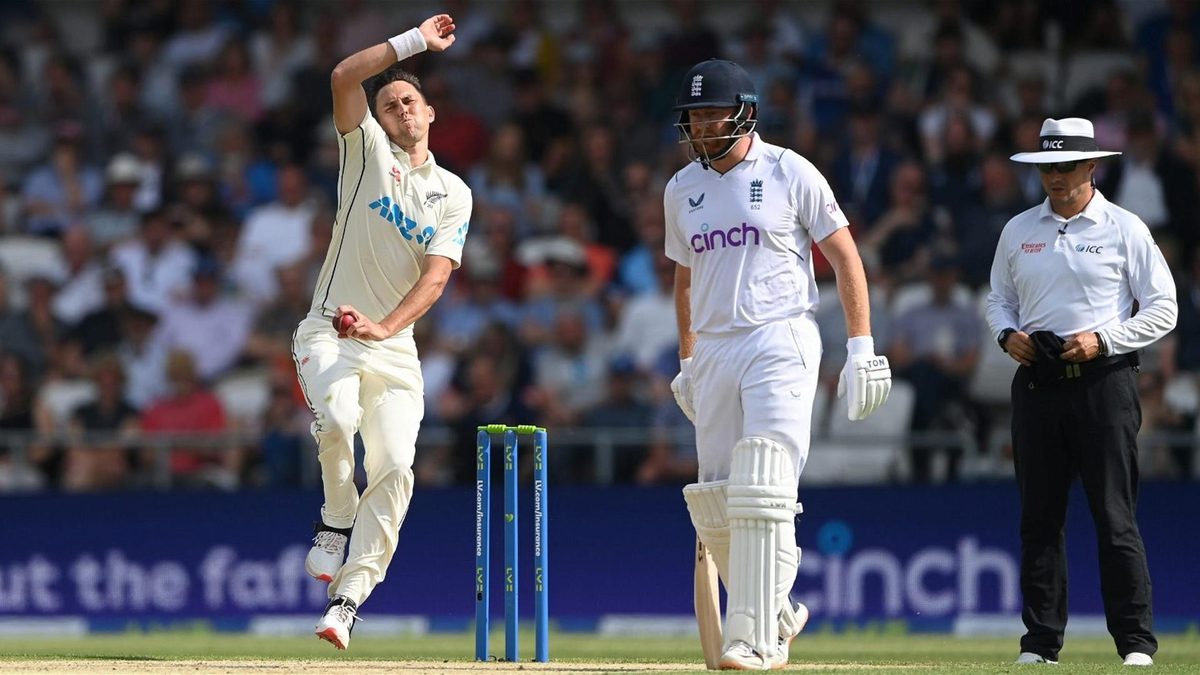
Phil Walker on an unhinged day at Headingley, from Trent Boult’s mastery to Jonny Bairstow’s masterpiece.
How can a game that’s basically gone on forever continue to make it up as it goes along? Seriously, how is it possible? Riddle me how this Victorian fluke, a curio at best, unrolled in 1877 to be passed into affectionate remembrance ever since, can continue to do this to us? When will it just turn it in and give it a rest?
We talk tiredly, and only really because we read it somewhere and it sounded cool, about the end of history. We lament, with due solemnity, that there are no new stories left, only old ones retold. Most of us (I can’t speak for you) drift about in a weightless state of almost perpetual weariness, dragging ourselves through the day on the off-chance that there’s another one tomorrow. The songs have been sung, the lies have been spun, and still the bastard won’t resign. Nothing shocks us anymore. We’re inured to everything this burning sphere of disappointment can throw at us. And yet this is what the punters, shaking their heads and looking at the floor, will be muttering to each other tonight: “I’ve never seen anything like that,” they will be saying.
“At least, not since last week.”
This one here, then, is Test match No.2467. It’s day two, and it’s Leeds, where the weirdness happens. New Zealand resumed on 225-5. Matthew Potts, a serious bowler for serious times, carried on hitting lengths in his sleep. Jack Leach toiled sweetly, eager to impress his big brother and ever so thankful for the chance. There were catches in the deep, and a murmur of loop and dip. He picked up five, deserved every pole (OK, four of them), and walked off with his shirt out.
In 1902, at The Oval, a skin-and-bones merchant called Jack Saunders from Melbourne, Victoria, clean-bowled England’s top three inside the first eight overs as the home side chased 263. Archie MacLaren (2) was the first to go, undone (I’m wagering) by the skittish lefty’s cutting in-duckers, followed by the equally legendary Johnny Tyldesley (0) and finally the theatrical aristocrat, Lionel Palairet, who mustered 6. Australia, you may recall, were cruising until a croucher with a mad streak called Gilbert Jessop took guard with nothing to lose. What Gilbert did next still stands alone. But they’re after him, hunting that number; and if Bairstow or Stokes don’t get him this week, they’ll go harder next.
Jack Saunders bowled quickish left-arm cutters. Trent Boult bowls left-arm fast. And between them, no one has ever done what they’ve done. Three clean-bowleds in the first four overs of an opening spell. Boult against England’s top order is, at the best of times, a rather unfair fight. But Boult inspired, fully grooved, armed with a hooping ball and a fuller length than at Lord’s or Trent Bridge, nurturing and channelling all that natural athleticism and loose-wristed artistry; Boult in his element, with a red ball and a murmur of cloud, from which flows an unforced and unshowy perkiness, a man at ease in his skin and his craft – when that Boult turns up, it’s less a contest than an exhibition.
Alex Lees was the first, compelled to have a dart at his second ball (dropped at slip) and then unable to locate by way of sound or eye where the follow-up had gone. (In fairness to him, that one would have bowled Lara.) Ollie Pope was the next to go, falling through the bar hatch and, stumps akimbo, swearing manfully into his helmet strap as he chuntered off. These two have at least got a little ‘credit’, but the fate of Zak Crawley seems to rest entirely in the toying hands of great fast bowlers. The whole ground knew what was coming. Crawley knew it too. But all that trained muscle memory and deep desperation was nothing against a thing that starts outside his naked off stump and demolishes the dignity of his leg pole: the feet flat, the front leg traumatically braced, the bat adrift like space junk floating in the ether. He has three knocks to save this iteration of his Test career.
At that one Boult essayed a little shriek and quickly remembered himself. England were 17-3 inside seven overs. CricViz put out the requisite tweet. No bowler ‘since records began’ had bowled more threateningly with a new red ball in England. Old Jack Saunders had just missed the cut.
When Root went to be followed by Stokes, punkishly refusing to play nice, England were five down for not much. A former New Zealand captain, watching on from the press box, and not unaware that the tourists have been harshly dealt with over the last few weeks, slapped the table at which he was sat and declared: “That’s what we wanted!”
Two hours later, at about 5:45pm in the evening, with 45 minutes still to play and Jonny Bairstow sniffing out the last few cuts and jibes of his first true masterpiece – an innings which, with a kind of eerie neatness, makes him just the third player after Shahid Afridi and, oh yes, Brendon McCullum to make consecutive Test hundreds at better than a run-a-ball – I went outside to get a hit from the crowd. On the way I passed one of English cricket’s more lugubrious former captains, a famed pragmatist with a seen-it-all air. He glanced up. “Fucking hell,” he said as he passed. No one knows anything any more. Nothing makes sense. Nothing, perhaps, except the essence of this game; a lunatic experiment, confounding us, over and over again.








